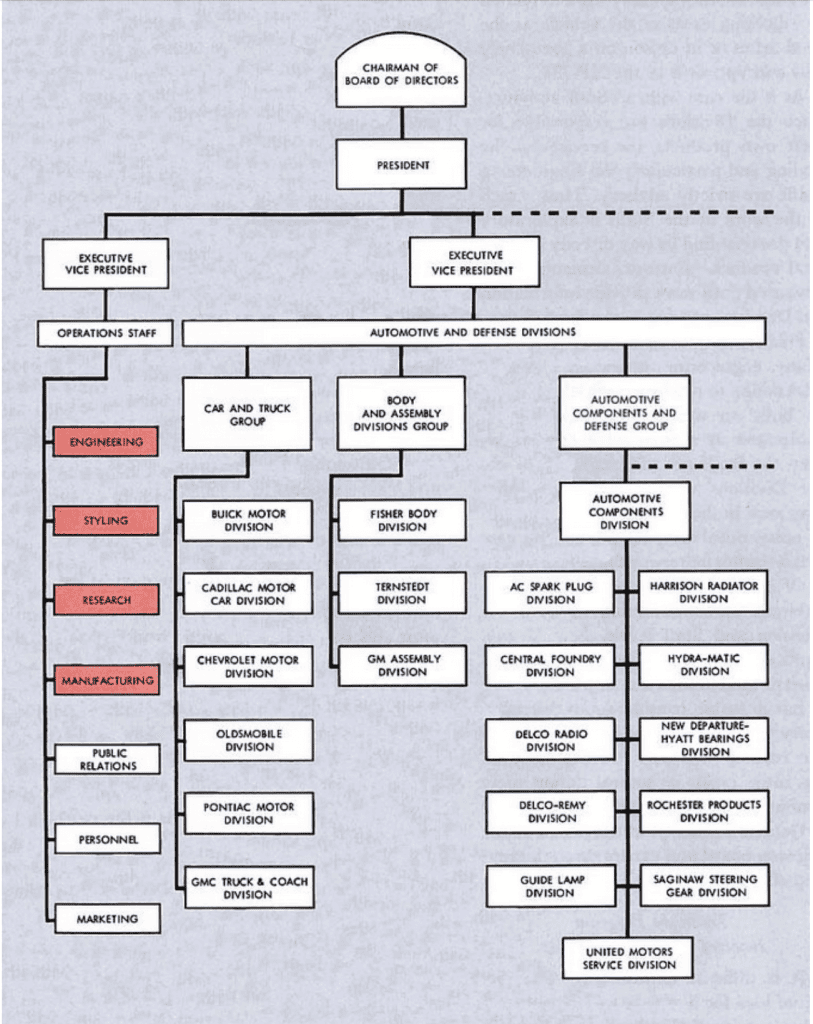An effective organizational structure, with a direct influence on employee management and performance, is what almost all companies, regardless of size, put in the top priority. For those companies that have complete product portfolios or multiple international markets, divisional organizational structures seem clearly effective. Is that true?
To answer this question, there is no better way than going further into this concept, learning from successful examples, and having a detailed evaluation of the divisional organizational structure toward the company's long-term goals. Check out this article and find out the best ways to structure or restructure your organization.
| What are the types of divisional organizational structures? | Product divisions, Customer divisions, Process divisions, and Geographical divisions. |
| Does Microsoft adopt a divisional organizational structure? | Yes, Microsoft has a product-type divisional organizational structure. |
| Is Nike a divisional structure? | Yes, Nike has a geographical divisional organizational structure. |
Table of Contents:
- What is the divisional organizational structure?
- What are the 4 types of divisional organizational structures and examples?
- Divisional organizational structure - Pros and Cons
- Leadership and management in divisional organizational structures
- Key Takeaways
- Frequently Asked Questions
Best Tips from AhaSlides
- Cross Functional Team Management | Build Better Workforce in 2025
- Why Employee Performance Evaluation Matters: Benefits, Types and Examples in 2025
- Top Management Team Examples for Better Team Performance in 2025

Looking for More Fun During Gatherings?
Gather your team members by a fun quiz on AhaSlides. Sign up to take free quiz from AhaSlides template library!
🚀 Grab Free Quiz☁️
What is The Divisional Organizational Structure?
The concept of divisional organizational structure stems from the need for decentralized decision-making and superb efficiency in large and complicated organizations.
The emergence of this organizational framework aims to promote each division to operate more independently and make decisions more quickly, which can lead to productivity and profitability. Each division might work as a stand-alone company, work on a specific purpose, and often incorporate most of the functional expertise (production, marketing, accounting, finance, human resources) that is needed to meet its objectives.
If you are wondering whether your company should build up a divisional organizational structure, it is acceptable to only meet one or more of the following conditions:
- Selling a sizable pool of customer-facing product lines
- Work on both B2C businesses-to-customer and B2B business-to-business services
- Aiming to target a wide variety of demographics
- Develop their brand in multiple geographic locations
- Serving major clients who need individualized attention
It is crucial to learn about the notion of multi-divisional organizational structure as well. They are both terms used to describe a type of organizational structure in which the company is divided into different divisions, each of which is responsible for a specific product, service, or geographic region. Indeed, they indicate the same concept. However, the only difference is the term "multi-divisional" is more commonly used in the United States, while the term "divisional" is more commonly used in the United Kingdom.
Related:
- Matrix Organizational Structure | Ultimate Key to Success
- Flat Organizational Structure: A Beginner’s Handbook
What are The 4 Types of Divisional Organizational Structures and Examples?
Divisional organizational structures are not all about products. This broad term can be narrowed into four focus types including product, customer, process, and geographical divisions. Each type of divisional organizational structure serves a certain organizational goal and it is crucial for a company to apply the right one.
Product divisions
Product division is the most common divisional organizational structure nowadays, which refers to how product lines define company structure.
General Motors, for example, developed four product-based divisions: Buick, Cadillac, Chevrolet, and GMC. Each division is fully supported by its own research and development group, its own manufacturing operations, and its own marketing team. It is believed that the divisional organizational structure was first developed in the early 1900s by Alfred P. Sloan, then-president of General Motors.

Customer divisions
For companies who have a complete customer portfolio, a customer division, or market-oriented division is more suitable because it enables them to better serve their various categories of customers.
A famous example of Johnson & Johnson’s 200. The company is the pioneer in grouping business segments based on customers. In this structure, the company classifies business into three fundamental segments: consumer business (personal-care and hygiene products sold to the general public), pharmaceuticals (prescription drugs sold to pharmacies), and professional business (medical devices and diagnostics products used by physicians, optometrists, hospitals, laboratories, and clinics).
Process divisions
Process divisions are designed to optimize the flow of work and information, rather than to maximize the efficiency of individual departments.
This framework works to optimize the end-to-end flow of different processes, for example, the completion of research & development on a product is a must before going to the process of customer acquisition. Similarly, the order fulfillment process can't begin until customers have been targeted and there are product orders to fill.
Geographical divisions
When corporations operate in several locations, a geographic divisional organizational structure is the best way to help a company quickly respond to customers at a local level.
Take Nestle as an example. This giant corporation sharpened its focus based on a geographical divisional structure with operations segmented into five key regions, known as new geographic Zones, from 2022. These regions include Zone North America (NA), Zone Latin America (LATAM), Zone Europe (EUR), Zone Asia, Oceania and Africa (AOA), and Zone Greater China (GC). All of these segmentations achieve promising annual sales.

Divisional Organizational Structure - Pros and Cons
The importance of divisional organizational structure is undeniable, however, note that it also brings numerous challenges. Here is an overview of the pros and cons of this structure that you should look at carefully.
| Advantages | Disadvantages |
| Encourage clear accountability, transparency, and responsibility within divisions. | Services must be duplicated across units, which leads to higher operating costs |
| Gives you a competitive advantage in local markets, and a faster response to local changes or customer needs. | Autonomy can lead to duplication of resources. |
| Enhance company culture by allowing for unique perspectives at different levels. | It can be hard to transfer skills or best practices across the organization. |
| The competitive environment can be healthy for innovation and improvement in each division. | Functional disconnection may happen as well as a rise of rivalries. |
| Facilitates company growth by breaking down departmental silos for scalability. | Potential loss of unity can be countered by fostering a strong sense of collaboration. |
Leadership and management in divisional organizational structures
What employers and leaders can do to help divisions overcome the challenges of divisional organizational structures. Here are some of the best recommendations from experts:

- Cultivating Collaboration and Teamwork: It is important for companies to maintain a strong sense of collaboration and teamwork between divisions. To achieve this, employers can encourage open dialogue between divisions and create a shared vision for the company, aligning all divisions with common goals.
- Promoting creativity and innovation: Product innovation, tech advancement, and customer service improvement are a few aspects that the divisional structure is making great effort on. To help employees generate creative thinking, leaders should emphasize empowerment and incentives.
- Facilitating focused teams with domain expertise: Effective leadership in a divisional organization is responsible to identify and nurture specialized talents within each division. Leaders should facilitate ongoing training and skill development to ensure that teams remain at the forefront of industry knowledge.
- Encouraging 360-degree feedback: Leaders should promote a culture of 360-degree feedback, where employees at all levels have the opportunity to provide input to their colleagues and leaders. This feedback loop helps in identifying areas for improvement, fostering personal growth, and enhancing overall team dynamics.
How to frame organizational structure effectively? When it comes to designing an organizational structure, there are four drivers to consider:
- Product-market strategies: How the business plans to direct each product-market field in which it will compete.
- Corporate strategy: What is the company's intention to achieve a competitive advantage over its rivals in the product-market extent?
- Human resource: The skills and attitudes of the employees and management levels within the organization.
- Barriers: PESTLE elements, including the cultural, environmental, legal, and internal factors can constrain the selection of procedure.
Key Takeaways
💡If you are looking for improved leadership and management where employees can improve their performance and engagement with the company, feel free to contact AhaSlides. It is an amazing presentation tool that allows interaction and collaboration among participants both in virtual and in-person settings.
Frequently Asked Questions
What is the divisional structure of an organization, for example?
In divisional organizational structures, a company's divisions can manage their own resources, essentially operating like stand-alone companies within the larger entity, with a separate profit-and-loss statement (P&L). It also means other parts of the business won't be affected if a division fails.
Tesla, for instance, has separate divisions for electric vehicles, energy (solar and batteries), and autonomous driving. This model allows it to address various industries and encourage each division to put priorities on innovation and advancement.
What are the 4 organizational structures?
The four types of organizational structures are functional, multi-divisional, flat, and matrix structures.
- A functional structure clusters employees based on specializations, in other words, the type of work they do, such as marketing, finance, operations, and human resources.
- Multi-divisional (or Divisional) structure is a sort of semi-autonomous division with its own functional structure. Each division is responsible for a specific product, market, or geographic region.
- In a flat structure, there are few or no layers of middle management between the staff and top executives.
- A matrix structure combines elements of both functional and divisional structures, where employees report to multiple managers:
Why divisional organizational structure?
It is stated that a divisional organizational structure can solve the problems of a centralized hierarchical organization. The reason is it enables the delegation of power between the parent organization (e.g., the headquarters) and its branches.
Is Coca-Cola a divisional organizational structure?
Yes, similar to many international companies, Coca-Cola uses the divisional structure of work by location. These divisions, which the company recognizes as target segments, are Europe, Middle East & Africa (EMEA). Latin America. North America, and Asia Pacific.
Ref: Indeed | Pressbooks








